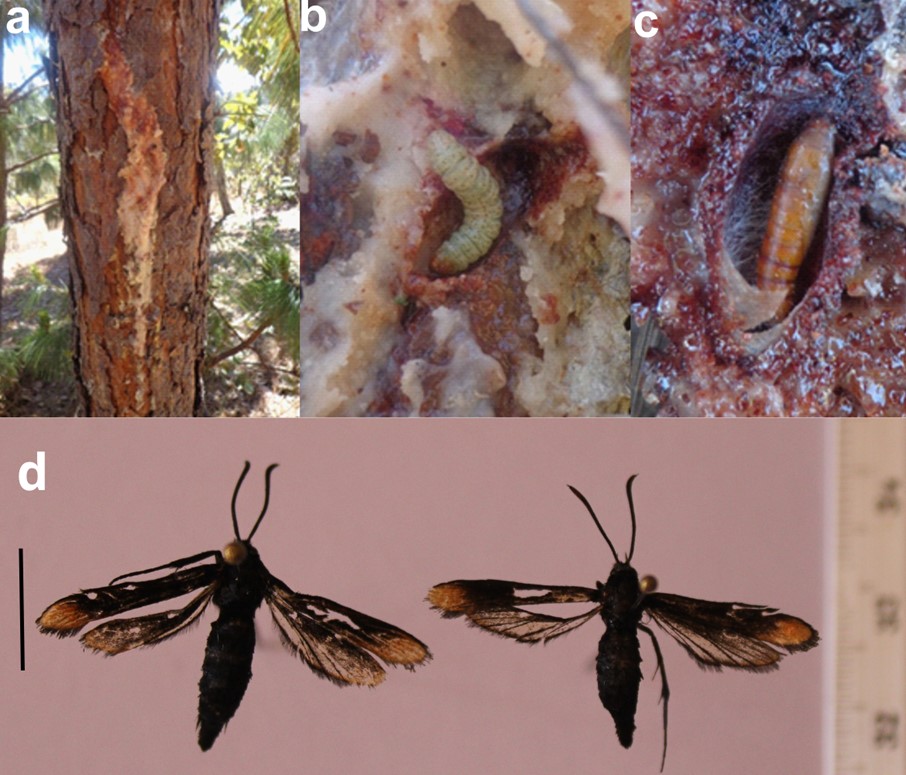Pine borer in forest fragments of Plan de Guadalupe, Atlamajalcingo del Monte, Guerrero
DOI:
https://doi.org/10.29298/rmcf.v14i77.1312Keywords:
Pine forest, Infestation, Guerrero Mountain, Forest pests, Symptoms, Synanthedon cardinalisAbstract
In recent years, in the temperate forests of the Montaña de Guerrero, pines with wilting, foliage yellowing, dry stems and some dead individuals have been observed, symptoms attributable to the attack of various organisms. The objective of this work was to identify the insects that cause damage to Pinus pseudostrobus Lindl., in pine forest fragments in the Plan de Guadalupe community, in addition to evaluate the level of infestation. Three 400 m2 sites were established to record the number of pitch masses on the stem, the normal diameter and other symptoms to determine the level of damage of each individual. Larvae and pupae were collected for their taxonomic determination. The pine pitch moth or pine borer Synanthedon cardinalis was the insect present in the stem of living pine trees in the study community. This is the first record of the species in the community of Plan de Guadalupe and for the state of Guerrero. It was observed that the larvae produce pink pitch masses, in addition, as they grow, they form tunnels in the phloem and the cambium area. The infestation level of the three sites was 9.09 %. The average height of the location of the pitch masses was 70.9 cm and the average number of pitch masses was 2.81.
Downloads
References
Billings, R. F., V. Espino. 2005. El Gorgojo Descortezador del Pino (Dendroctonus frontalis) como reconocer, prevenir y controlar plagas, Nicaragua: Texas Forest Service. https://pdfslide.net/documents/web-viewel-gorgojo-descortezador-del-pino-dendroctonus-frontalis-en-centroamrica.html?page=1. (22 de febrero de 2022).
Beutelspacher B. C. R. 1983. Redefinición taxonómica de Montezumia cardinalis Dampf. (Lepidóptera Sessidae). Ciencia Forestal 8(43):24-32.
Cibrián T., D., M. Méndez, J. T. Campos B., H. O, Yates l., y L. J. Flores. 1995. Insectos forestales de México. Universidad Autónoma Chapingo, México. 453p.
Cibrián T., D., S.A. F. Quiñones, S. B. Quiñones, S. U. Robles, L. V. Hernández, E. A. S. Gamboa, J. L. V. Aguilar, L.C. Arango. 2015. Manual para la identificación, manejo y monitoreo de insectos descortezadores del pino. Comisión Nacional Forestal. 62p.
https://cienciasforestales.inifap.gob.mx/index.php/forestales/article/view/1119/2468. (25 de enero de 2022).
Comisión Nacional Forestal (CONAFOR). 2021. Diagnóstico Fitosanitario del Estado de Guerrero. Gerencia Estatal Guerrero. http://sivicoff.cnf.gob.mx/ContenidoPublico/02%20Informes%20de%20acciones%20operativas/DiagnosticosEstatales/2021/Guerrero.pdf. (17 de agosto de 2022).
Del Río, M. A. 1990. Biología y control químico de Synanthedon cardinalis Dampf (Lepidoptera: Sesiidae) en la Sierra Purépecha, Michoacán. Rev. Ciencia Forestal en México 15(68): 3-27.
Gentry, C. R. and J. M. Wells .1982. Evidence of an oviposition stimulant for peachtree borer. Journal of Chemical Ecology 8: 1125-1132. Doi: 10.1007/BF00986983. DOI: https://doi.org/10.1007/BF00986983
Hernández H., M. S. 1983. Biología de Synanthedon cardinalis Dampf (Lepidoptera: Sesiidae). Ciencia Forestal 8 (43): 39-64.
Instituto Nacional de Estadística Geografía e Informática (INEGI). 2008. Conjunto de datos vectoriales escala 1:1 0050 000. INEGI. https://www.inegi.org.mx/temas/climatologia/#Descargas. (22 de abril de 2022).
Instituto Nacional de Estadística Geografía e Informática (INEGI). 2017. Carta de Uso del Suelo y Vegetación Serie VI (2014), escala 1:250 000. INEGI. México. 2017. https://www.inegi.org.mx/temas/usosuelo/#Descargas. (22 de abril de 2022).
Instituto Nacional de Estadística Geografía e Informática (INEGI). 2020. Datos Tabulados: Guerrero. https://www.inegi.org.mx/contenidos/app/areasgeograficas/resumen/resumen_12.pdf. (22 de abril de 2022).
Márquez, L. J. 2005. Técnicas de colectas y preservación de insectos. Boletín Sociedad Entomológica Aragonesa 1 (37): 385-408. 385https://www.academia.edu/3744876/T%C3%A9cnicas_de_colecta_y_preservaci%C3%B3n_de_insectos. (22 agosto de 2021).
Pacheco F., C., A. E. R. Castro, J. L. C. León., S. C. Ramírez. 2006. Biología de Acharia extensa (Schaus, 1896) (Lepidoptera: Limacodidae) en cultivo de café en La Montaña de Guerrero, México. Dugesiana 13 (2): 67-72. http://www.bio-nica.info/biblioteca/Pacheco2006Limacodidae.pdf. (22 de julio de 2022).
Peralta M., M. J., J. L. Alba. 2004. Evaluación del ataque de Synanthedon cardinalis (Dampf) en progenie de Pinus patula Schl. et. Cham., procedentes de huertos semilleros de 1ra y 2da generación de selección. Foresta Veracruzana, 6:27-31. https://www.redalyc.org/pdf/497/49760106.pdf. (15 de julio de 2022).
Ruiz M., C., R. G. Sánchez y H. V. Viveros. 2018. La palomilla resinera Synanthedon cardinalis (Dampf) (Lepidoptera: Sesiidae) y su distribución en el centro de Veracruz, México. Acta Zoológica Mexicana 34(1):1-9. https://go.gale.com/ps/i.do?id=GALE%7CA597615639&sid=googleScholar&v=2.1&it=r&linkaccess=abs&issn=00651737&p=AONE&sw=w&userGroupName=anon%7E67e0f88a. (22 de julio de 2022). DOI: https://doi.org/10.21829/azm.2018.3412139
SEMARNAT. 2017. Informe de medio ambiente: Ecosistemas terrestres. Sistema Nacional de Información Ambiental y de Recursos Naturales. https://apps1.semarnat.gob.mx:8443/dgeia/informe18/tema/cap2.html#tema4. (22 de febrero de 2022).

Published
How to Cite
Issue
Section
License
Copyright (c) 2023 Revista Mexicana de Ciencias Forestales

This work is licensed under a Creative Commons Attribution-NonCommercial 4.0 International License.
The authors who publish in Revista Mexicana de Ciencias Forestales accept the following conditions:
In accordance with copyright laws, Revista Mexicana de Ciencias Forestales recognizes and respects the authors’ moral right and ownership of property rights which will be transferred to the journal for dissemination in open access.
All the texts published by Revista Mexicana de Ciencias Forestales –with no exception– are distributed under a Creative Commons License Attribution-NonCommercial 4.0 International (CC BY-NC 4.0), which allows third parties to use the publication as long as the work’s authorship and its first publication in this journal are mentioned
The author(s) can enter into independent and additional contractual agreements for the nonexclusive distribution of the version of the article published in Revista Mexicana de Ciencias Forestales (for example, include it into an institutional repository or publish it in a book) as long as it is clearly and explicitly indicated that the work was published for the first time in Revista Mexicana de Ciencias Forestales.
For all the above, the authors shall send the form of Letter-transfer of Property Rights for the first publication duly filled in and signed by the author(s). This form must be sent as a PDF file to: ciencia.forestal2@inifap.gob.mx
This work is licensed under a Creative Commons Attribution-Noncommercial 4.0 International license.






